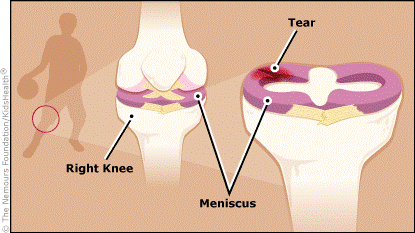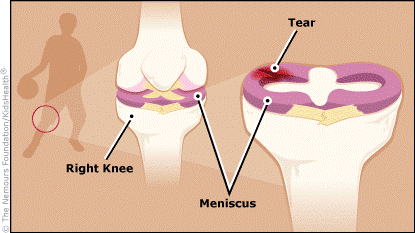
DO I NEED SURGERY FOR MY KNEE INJURY?
Everyone is very excited that spring has arrived so we start our many outside activities and sports. Today, we’ll be addressing the topic of a common knee injury, a meniscus tear, that can occur in anyone from the recreational athlete to the walker or avid gardener. To answer some questions regarding meniscus tears, we spoke with Dr. Brian Wittenberg, an orthopedic surgeon with Bay Street Orthopaedics.
What is the meniscus?
The meniscus is a highly specialized disc-shaped cartilage cushion that sits between the fem ur and the tibia to protect the all important articular cartilage.
ur and the tibia to protect the all important articular cartilage.
Photo courtesy of www.rchsd.org
What causes a meniscus tear?
The most common reason for injury is a squatting or twisting motion. Common activities include skiing, tennis, misstepping into a hole while walking, or even getting up from the garden.
What are the symptoms of a meniscus tear?
The most common symptom is sharp, burning pain with squatting or twisting activities. Sometimes, a person can feel the knee catching or snapping which the torn meniscus fragment is flipping in the knee joint.
Can a meniscus tear be fixed?
Depends on the type of tear. About 10% of meniscus tears are amenable to repair. 90% are best treated by trimming the torn fragment to quickly return to symptom free activities.
Do all meniscus tears require surgery?
No, those meniscus tears resulting in minimal symptoms are best treated non-operatively. (Sometimes, the meniscus is just stretched, not torn). If symptoms become irritable enough to the patient, then arthroscopic intervention should be considered.
What are the benefits of each option?
Obviously, if the symptoms are minimal or can be reduced with a conservative treatment plan (ie. anti-immflamatories, topical ointments, activity modifications and a strengthening program) then surgery would not be indicated. Often, patients do well with either a home exercise or a supervised physical therapy program to maximize the rehabilitation process.
Surgery is usually indicated if the patient is experiencing pain which makes them unable to perform their activities. Every tear is different and every patient’s pain tolerance and activity level is different. Arthroscopic surgery is a minimally-invasive outpatient procedure that commonly results in rapid resolution of symptoms in three days to three weeks. Of course sometimes this takes longer. Physical therapy often speeds the rehabilitation process.
Conservative physical therapy can take 4-8 weeks depending on the severity of the symptoms. RICE (rest, ice, compression and elevation) plays a big role in the initial stages. Physical therapy can assist in return to functional goals including return to activity and sports if symptoms do not increase or persist. If pain and symptoms persist or worsen, you are referred back to your orthopedic surgeon for surgical intervention.
Post surgical physical therapy is often 4-6 weeks after surgery. The goals of physical therapy are to gain motion back, increase strength and return you to the sport or activity that you love.
Overall prevention is key!
1) Flexibility – get a good stretching program and perform regularly.
2) Dynamic warm up prior to exercise – get the blood flowing and the muscles pumping.
3) Strengthening of the hip, thigh and core.
4) Avoid overtraining!
5) Sport specific or activity specific training/functional strengthening.
6) Cool down with a great static stretch after activity.
When in doubt, check with your physician, athletic trainer, or physical therapist to prevent injury and ensure you are ready to begin your exercise program to prevent a knee injury!
4048 Cedar Bluff Drive • Suite 1
Petoskey, MI 49770
231-347-5155 • 800-968-5155




 Dr. Brian Wittenberg
Dr. Brian Wittenberg



